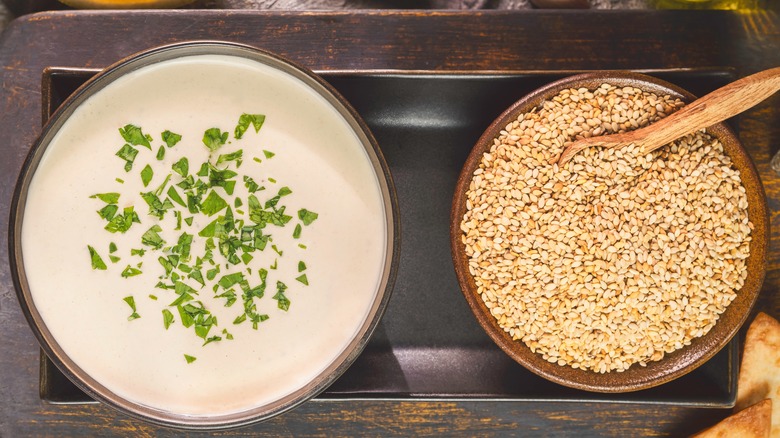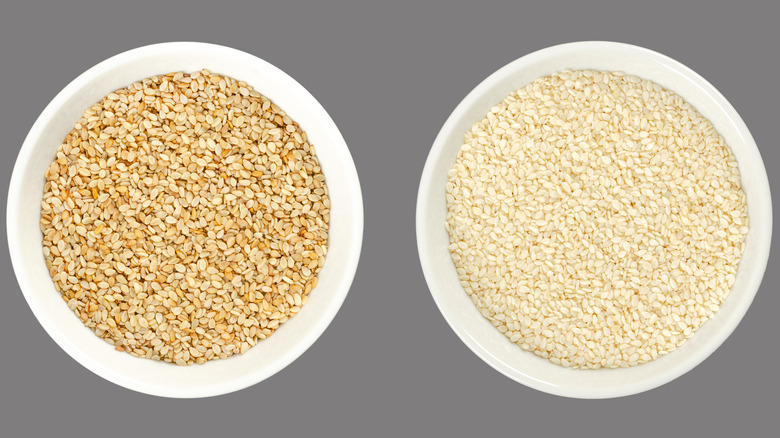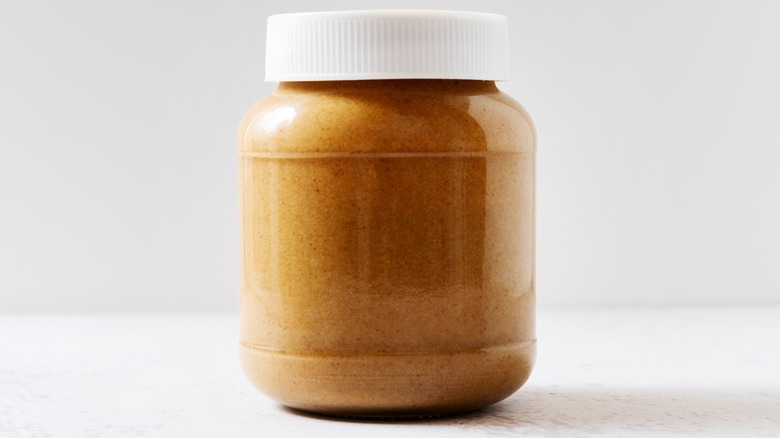Types Of Tahini, Explained
There are many ways to cook with tahini. Tahini is a paste made from sesame seeds that's light brown and creamy at room temperature. Its consistency is fatty and smooth, not unlike nut butters, and there are several different forms of it. Traditional Mediterranean and Middle Eastern dishes that feature the ingredient are halva, hummus, baba ganoush, among many others, says Cully's Kitchen. Often, tahini is used as a thickening agent, and you can even use it to make these tahini chocolate chip cookies.
Tahini's parent plant, sesame (sometimes known as benne), is native to Africa and Asia. Ancient Egyptians ground it up to make grain flour; Romans spread it over bread. These days, the crop is more common because it's grown globally in hot climates, and it's not unusual to find sesame seeds garnishing and flavoring items such as sushi and bagels. Sesame's nutty, oily seeds have many applications, but tahini is one of the most delicious. Still, not all tahini is the same, and it can be helpful to know the difference between unhulled and hulled and raw and roasted tahini.
Unhulled vs. hulled tahini
The first thing to consider with tahini is whether it's hulled or unhulled. Hulling is the process of removing the shell from the seed before grinding it up. This act can significantly affect the flavor and texture of the tahini and how it's used. For unhulled tahini, the whole sesame seed and its kernel (outer hull) are included. This form of tahini has greater levels of both calcium and fiber than its hulled counterpart. It's also crunchy, complex, and rough. You can usually identify it by its potent, bitter taste and dark appearance. MasterClass notes that unhulled and roasted tahini is one of the easiest to find and that this combination has the deepest possible flavoring, making it excellent for baking.
Hulled tahini, on the other hand, does not use the kernel. As such, it's lower in calcium and fiber and tastes lighter and somewhat sweet. The sesame seeds have their shells removed by wet dehulling, according to LEAFtv. Machinery cleans, peels, and grinds the seeds. It's a whole process, but you can also do this at home by soaking or drying the seeds overnight. The resulting mixture is lighter and creamier than unhulled tahini, per Mayver's. Hulled tahini works well in sweet items, dressings, and this green goddess dip and crudités platter. Mayver's even recommends drizzling it plain over sweet potatoes.
Raw vs. roasted tahini
The second thing to consider is whether your tahini is raw or roasted. Roasting is a straightforward process, but like hulling, it can have noticeable effects. In this context, toasting and roasting are often interchangeable, per CookThink, so don't get confused if you find "toasted" on the label. And sometimes, roasted/toasted tahini is called "sesame paste" to set it apart.
Raw tahini, because it hasn't been roasted or toasted, is lighter in color and taste but retains a lot of nutritional content. Its flavor profile is best in desserts, hummus, and sauces/dressings. On the other hand, roasted tahini is darker, has more robust flavors, though some of its nutrients have been cooked away. This nuttier, toasted version is popular in Chinese cuisine. It can be used in dips or dressings, but it's also great as a spread, put in noodles, or added to soups, according to CookThink.
Whether you go unhulled or hulled, raw or roasted, tahini can be found in the condiment aisle of most supermarkets. Tahini is stored in glass or plastic jars, and you should mix it before serving as it can easily separate. After opening, the jar can be stored in the refrigerator for several months. Just be sure to grab the right type for your tahini needs!


